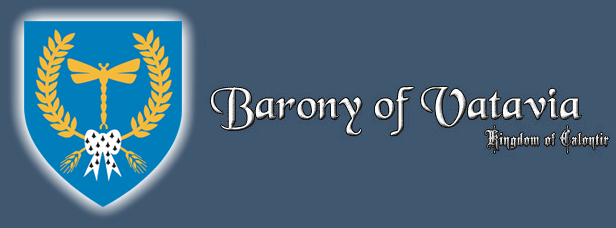
Shakespeare in Love: A Review
by Friar Thomas Bacon (David Moreno)
Orignally published in the June 1999, A.S. XXXIV issue of the Dragonflyre, a publication of the Barony of Vatavia.
Unlike previous movies I have reviewed, “Shakespeare in Love” is not about historical events, but a piece of fiction about historical persons. As such, to point out historical inaccuracies makes no sense as it is fantasy not reality. Yet it is remarkable how little violence to history the film makers inflicted to tell their tale. Thus my endeavor to say how much they got right, rather then to say what they got wrong.
I will say however how, like in all movies, they fudge the timeline. The movie is expressly set in 1593. The first known performance of “Romeo and Juliet” occurred in 1595. While Shakespeare was with the Admiral’s Men in ‘93, by ‘95 he was with the Chamberlain’s Men. “Twelfth Night”, the opening of which Will and Viola sketched at the end of the move, was really written at the end of 1600. The theaters were closed between September ‘92 and June of ‘94 because of the plague. The greatest distortion of the timeline, however, is Wessex’s Virginia plantations. The famous Lost Colony of Roanoke was discovered missing just two years prior, and Jamestown was fourteen years in the future. His plantations are pure fiction.
One of the challenges of a movie like this is to try to disentangle Shakespeare’s words from those of the screenwriter’s. Besides “Romeo and Juliet”, the other play most prominently used is “Two Gentlemen of Verona”, which indeed predates “Romeo and Juliet”, and is the play being presented to the royal court. The soliloquy with which ‘Thomas Kent’ auditions is Valentine’s from Act III, scene 1. And yes, there is a scene with a clown and a dog, in fact two.
In one of the setup scenes established that Shakespeare’s wife Ann is not with him, and that they are estranged. Which was indeed true. There is no evidence that Ann was ever with him during his sojourn in London. The reasons are unknown, but since Ann came from a Puritan background, it is speculated that she disapproved of her husband’s chosen career and would have nothing to do with it.
So little is known of Shakespeare’s personal life that he even would have an affair is pure speculation. The closest evidence of such a thing is the mysterious “dark lady” of the sonnets. And even that is ambiguous to the extreme. It is the void of information that allows the supporters for alternate authors of the plays free reign of their imagination.
Philip Henslow was a real person and was the owner of the Rose. And while he was certainly under financial pressure in 1593 because the theaters had been declared closed, that he was being shaked down by a Mr. Fennyman is a fiction of the movie. The movie does a fair representation of how a play was produced. The main difference, necessary for the plot of the movie, is that a play would be written out in full before anything else was done, and later trim to fit the necessaries of production. This was because before a play could be produced it had to be registered with the Master of the Revels. And once that was done, nothing could be added.
An interesting twist was the use of Christopher Marlowe. While the two certainly knew of each other, but no doubt it went little beyond that as at the time Marlowe was at the top of the profession, while Shakespeare was still just starting out. Marlowe was indeed killed in a tavern fight over a bill in May of 1593. But as it is known that he did espionage work for Elizabeth, and the circumstances about his final days have lead to suggestions that there were darker motives for his death. That he knew too much, and his free thinking ways were too much of a risk.
At the end of the movie there is a cute scene in which Elizabeth comes up to a mud puddle and stops expectantly. There is a short pause before the courtiers, who are all bowing, realize what the Queen is waiting for and start fiddling with their capes. By this time, Elizabeth, tired of waiting proclaims “Too late, too late,” and resolutely stomps across. This is of course a play on the legendary story of Sir Walter Raleigh using his cloak to allow Elizabeth passage over a puddle. The story is the probable fiction of Thomas Fuller, a historian who wrote in the period after the English Civil War, who was noted for his elaboration. It is best known from Sir Walter Scott’s “Keniworth.”
It would be pendent to note here the failure of logic at the end of the movie. How did the Lord of the Revels known that a woman was on the stage at “The Curtain”, Viola was substituted in literally as Juliet made her first stage entrance? How did the Queen come to be at this first performance, and arrived and entered unnoticed? How did she know Viola’s stage name? How did she know Shakespeare was at Greenwich masquerading as Viola’s attendant? And how did she know that it was he who shouted out the fifty pound wager? It’s a mystery.
Bibliography
Chute, Marchette. Shakespeare of London. New York: E.P. Dutton, 1949.
Evans, G. Blakemore, ed. The Riverside Shakespeare. Boston: Houghton Mifflin Co., 1974.
Wallechinsky, David, and Irving Wallace. The People's Almanac #2. New York: Bantam Books, 1978. pp. 1239.
Copyright © 1997 - present His Lordship Friar Thomas Bacon (David Moreno). All rights reserved.